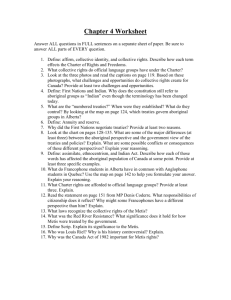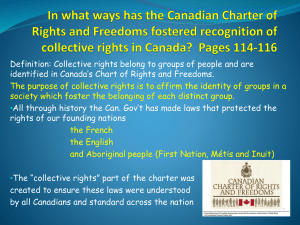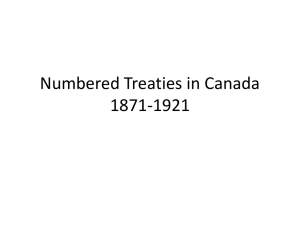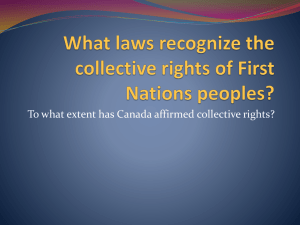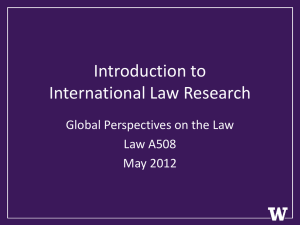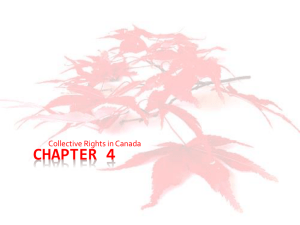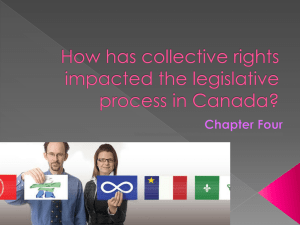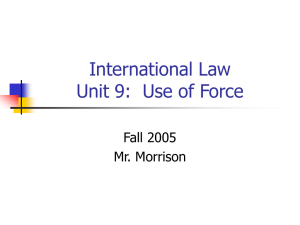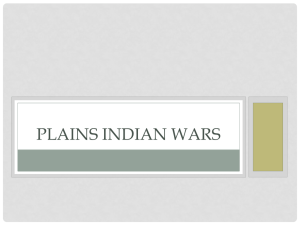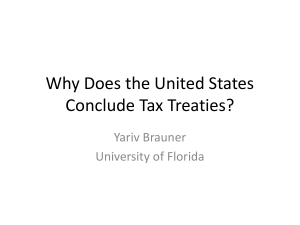Chapter 4 Collective Rights
advertisement
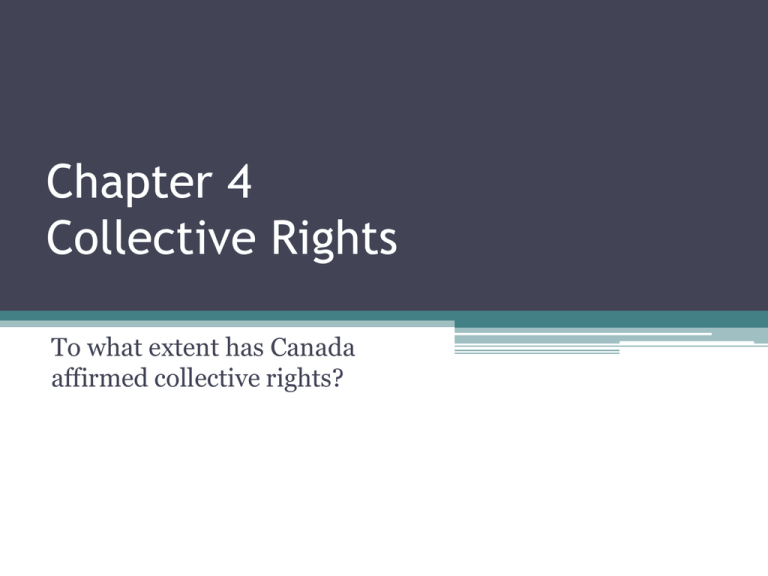
Chapter 4 Collective Rights To what extent has Canada affirmed collective rights? Terms to Know: • Terms Handout Aboriginal rights: stem from a custom, a practice or a tradition that characterizes the culture of an Aboriginal group. This right had to exist prior to the contact with the Europeans; it is most often associated with a territorial occupation since that period. Moreover, the courts have ruled that an Aboriginal nation present on a territory when the Europeans arrived—and that has continued to frequent the territory ever since—has specific rights on that territory, known as “Aboriginal rights.” Treaty rights: are special rights to lands and entitlements that First Nations people legally have as a result of treaties signed with the Queen and Canadian government; rights protected under section 35 of the Constitution. Lets Think: • What is collective rights ? • What groups in Canada are recognized in the charter as having collective rights? • Why is Canada the only country in the world that has collective rights for specific groups set out in it constitution? • Why are collective rights important to all Canadians? • FAQ, pg 122 What Laws Recognize the Collective Rights of First Nations peoples? • We will talk about legislation that affects the collective rights of First Nations peoples ▫ Numbered treaties and how they have been interpreted ▫ Modern treaties ▫ The goals of the Indian Act ▫ The changing Indian Act Numbered Treaties • Historic agreements that affect the rights and identity of some First Nation groups in Canada • They have roots in royal proclamation of 1763. Britain sought to establish control over lands they had just claimed from France • The proclamation recognized First Nations rights to the land and established the principles for making treaties through peaceful negotiation • Numbered treaties were agreements between the Queen and First Nations • First nations agreed to share their lands and resources • The government of Canada agreed to terms covering first nations education, reserves, annuities, and other matters Why? • Why did First Nations in the west and Canada negotiate the numbered treaties? • Read pg. 126 • Canada wanted to build a railway • Both sides wanted to avoid war. • First nations wanted to secure their future Houston we have a problem…. • So if both parties agreed on these treaties then there should be no problem right? wrong • Canada’s government believes First Nations gave up their land under the treaty. First Nations disagree ▫ First nations people at the time did not think of land as something anyone could own or give up • First nations recorded the treaties in their oral histories in their own language • Canada’s government recorded the treaties in writing in english ▫ The oral and written records disagree on key aspects The Indian Act • The Indian Act demonstrated something important about the way the Canadian Government understood treaty rights • Video • The Numbered Treaties confirmed the Canadian Governments duty to protect rights of First nations. Under the act, the federal government is able to develop specific policies and programs to administer treaty rights • The act created officials for each reserve, “Indian Agents”, who had the power to decide how the government would full fill its duties ▫ This meant that there were many interpretations of what treaty rights meant on a case by case basis ▫ Why would this be a problem? • The Indian Act dates back to 1876, at that time the Canadian Government thought it was appropriate to make laws for first Nations without consulting them ▫ Ethnocentrism-the belief that your culture and way of doing things is better then others • The Act Defines who may be registered as a “status Indian” with treaty rights. This meant that the government, not the First Nations themselves made all the decisions ▫ The Indian act was, and still is a way for the government to administer treaty rights • The act originally aimed to assimilate First nations peoples • It defined how first nations had to govern themselves • At points in history it restricted the way they could dress, travel, and protest • Until 1960, in order for a First Nations person to be able to vote they had to give up their treaty rights • The act has been revised several times and remains in force today • Based on what you now know, how do you feel about the Indian Act? • What does the Indian Act violate? (hint we talked about it last chapter) • Read the Article on page 138 • What should be done about the Indian Act today? ▫ What do First nations think should be done? ▫ What does the Gov think needs to happen? • Complete the “two views” worksheet What Collective Rights do Official Language Groups have Under the Charter? We will be exploring….. • What are the collective rights of Francophone's and Anglophones in the charter of rights and freedoms? • How do their collective rights affect their quality of life? • What are the background in regards to the history of the rights of Canada’s official language communities. • You have moved to a foreign country and, upon your arrival, you realise that you are the only person of your ethnic, cultural, religious and language group to be seen. The country is not racist or discriminatory; you are accepted as part of the community. What will this feel like? How might this affect your daily activities? How will this impact your quality of life? What are Official Language Minorities? • Explore the map on pg. 142 • Lets discuss the question on the bottom of the page • Read pg 143 and 144 • What do these two students have in common? • How do their collective rights affect their quality of life? • How do Rachel and Devin represent the concerns of a minority language speaker? What are the Charter Rights of Official Language groups? • Official Bilingualism ▫ Section 16 to 20 of the charter establishes French and English as the official languages of Canada ▫ Both languages have the right to conduct affairs with the federal government in either official language ▫ New Brunswick is an officially bilingual province • Minority Speaking Education Rights ▫ Section 23 of the charter states that any minority speaking population of sufficient size has the right to publicly funded schools that serve their language community Ex. Beaumont, Alberta The History of Francophone's in Canada • 1608- Samuel de Champlain founds Quebec City and establishes New France • 1774-Britain passes the Quebec act, recognizing the rights of Francophone's • 1867-Confederation establishes Canada as a bilingual nation • 1969- Official languages act reasserts the equality of French and English in Canada • 1982-Charter of rights and freedoms confirms official bilingualism How has the Charter affected Francophone Education? • Rights for francophone's and Anglophones are what made confederation possible • Under the BNA act in 1867, confederation established Canada as a bilingual nation • It guaranteed public money for minority schools everywhere in Canada ▫ Protestant/English School in Quebec ▫ Catholic/French school in the rest of Canada Pg 147 • The Manitoba School Act • Haultain Resolution and North-West Territories Ordinance Number 22 ▫ In what way did these acts call the founding principles of confederation into Question? Language Minority Education Today • When Trudeau established the Canadian Constitution in 1982, he used it as an opportunity to restore the education rights of minorities • The results can be seen in the chart on pg 148 • How has section 23 (huh, what's this?) impacted minority education across Canada? • How does the chart on p. 148 convey the impact of section 23 of the Charter? Bill 101 – Charte de la Langue Francaise • In 1977, the provincial government of Quebec passed Bill 101 to establish rules to protect the French language in Quebec • This law affirmed the French language as essential to the identity of Francophones • It made the French language the official language of business, government and education in Quebec Bill 101 • Bill 101 is Official • Bill 101 – 5 Years Later • Bill 101 – 20th Anniversary • How has Bill 101 Affected Anglophones in Quebec? • How has Bill 101 served to Protect the rights and Identity of Francophones in Quebec? • Read the chart on pg 150 and complete the worksheet (Bill 101 and the Canadian CRF) What laws recognize the collective rights of the Métis? Terms you should already know.. • Métis – descendents of mixed First Nations and European (mainly French) heritage • Inherent rights – rights with origins in fundamental justice; rights associated with history or tradition • Scrip – a document that could be exchanged by the Métis for land • Autonomy – authority to make decisions Métis Rights…how did they get where they are today? • Read pgs 153 to 158 and create a timeline for yourself in your notes For each event state: 1. Date 2. What Happened 3. Why it was important Louis Riel- a Father of Confederation • Louis Riel led the Northwest resistance which ended in military conflict between the Métis government and the Canadian government • The Canadian Government did not respond to the Métis Request petitions for land and collective rights • Louis Riel is considered the founder of Manitoba • Louis Riel was hung for treason in 1885 • Many Anglophones agreed with the sentence, while many francophones opposed and saw it as a betrayal to French/English alliance Pre-Test Questions • This worksheet is meant to help you study for the exam. The greater detail you can answer the questions, the better shape you’ll be in for the test
